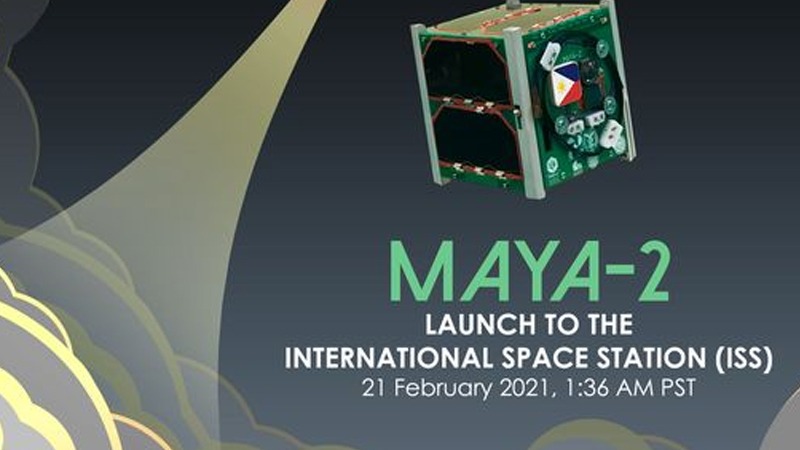The country witnessed another historic moment as its second cube satellite (CubeSat) Maya-2 was successfully launched to the International Space Station (ISS) Sunday, February 21, 2021 at 1:36 A.M. (PHT) aboard the S.S. Katherine Johnson Cynus spacecraft.

Sending the satellite into the ISS is the final step before the satellite reaches its targeted altitude in Low Earth Orbit, when the space station deploys it at a date to be determined later.
Maya-2 CubeSat was launched through the ISS along with Paraguay’s GuaraniSat-1 CubeSat, and Japan’s Tsuru CubeSat for the BIRDS 4 Satellite Project – KyuTech, aboard the Northrop Grumman CRS-15 mission.

Science Secretary Fortunato T. de la Peña said Maya-2 is the country’s fourth satellite and was launched through the International Space Station (ISS).
“Since DOST started the Philippine Space Technology Development Program in 2014, we already sent two micro satellites, Diwata-1 and Diwata-2, and two nanosatellites Maya-1 and Maya-2, into space orbit,” de la Peña said. Two more (Maya-3 and Maya-4), are to be launched within the year.

Developed by three Filipino student engineers, Maya-2 CubeSat weighs 1.3 kilograms and is equipped with a camera for image and video capture, attitude determination and control units for active attitude stabilization and control demonstrations, Perovskite solar cells and Latchup-detection chip, and an Automatic Packet Reporting System Message Digipeater (APRS-DP).
According to Professor Paul Jayson Co, project leader of the STAMINA4Space Space Science and Technology Proliferation through University Partnerships (STeP-UP), the satellite uses commercial off-the-shelf (COTS) components to verify proper functions in space and the information gathered from BIRDS-4 will form the basis for usage of these COTS components for future space missions.
Co said the satellite also carry a store-and-forward payload that can be used to gather data from ground sensors for more practical applications like for weather and infectious disease analysis.

(BIRDS-4-PH-Team-Photo-courtesy-of-BIRDS-4-2)
The Maya-2 CubeSat team is led by BIRDS-4 Project Manager Izrael Zenar C. Bautista, with BIRDS-4 Project members Mark Angelo C. Purio and Marloun Sejera.

Bautista is an BS Electronics and Communications Engineering and MS Energy Engineering graduate from the University of the Philippines Diliman. As BIRDS-4 Project manager, he monitors the team’s planning, design, execution, implementation, and operations. He also supervises outreach, team events, and coordination between stakeholders.

Purio has an Electronics and Communications Engineering degree from Batangas State University, MS Electronics Engineering from De La Salle University and MA in Education from Adamson University. He is responsible for the Camera Mission (CAM) of the BIRDS-4 Satellite Project, which captures images using a commercial-of-the-shelf (COTS) camera. He assisted in the design and development of a standardized backplane board (BPB) which holds the boards together and serves as a bus for inter-board connections and power supply.

Sejara earned his degrees in BS and MS in Electronics and Communications Engineering from the Mapúa Institute of Technology. He was charged with ensuring the satellite maintains reliable communications with ground stations for the continuous execution of its missions. He also handles the Automatic Packet Reporting System – Digipeater (APRS-DP) mission which aims to demonstrate the functionality of low-cost Commercial off-the-shelf (COTS) APRS digipeater and provide amateur radio service to the amateur radio community.
The three Filipino space engineers are now pursing doctoral degrees in Space Systems Engineering and Space Engineering at the Kyushu Institute of Technology (Kyutech).

The development of Maya-2 CubeSat is part of the 4th Joint Global Multi-Nation Birds Satellite project BIRDS-4 Satellite Project, a cross-border interdisciplinary CubeSat project hosted by the Kyushu Institute of Technology in Japan, in collaboration with the three countries.

De la Peña said DOST’s Advanced Science and Technology Institute (ASTI) and the University of the Philippines Diliman’s Institute of Electrical & Electronics Engineering (UP IEEE) are the implementors of the satellite development projects in cooperation with two Japanese universities, Hokkaido University and Tohoku University.
This initiative is also part of the Stamina4Space Program of the DOST funded by the Philippine Council for Industry, Energy, and Emerging Technology Research and Development (PCIEERD) and implemented by the Advanced Science and Technology Institute (ASTI).
The Space Technology and Applications Mastery, Innovation and Advancement (STAMINA4Space) Program is a space research and development program which aims to further develop deep expertise to enable and sustain the growth of a local scientific-industrial base in space technology and applications in the Philippines.
Moving forward, these projects are seen to further intensify the efforts of the country to harness the power of satellite technology for other purposes such as agriculture, forest cover and natural resources inventory, weather forecasting, and disaster damage assessment and monitoring, among others.
De la Peña revealed the Philippines is aggressively pursuing its space development program because of its many benefits to Filipinos.
“The succeeding micro satellites Diwata-3 and Diwata-4 and succeeding nanosatellites are now in various stages of development, now done completely in the Philippines,” he said in a press statement. (S&T Media Service)
-30-
